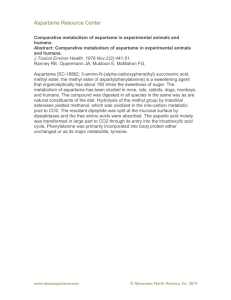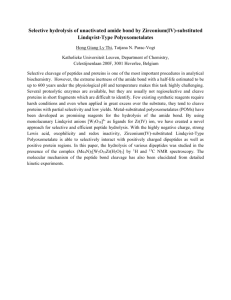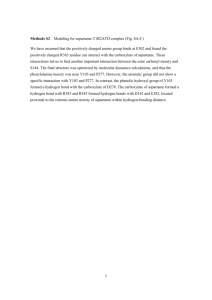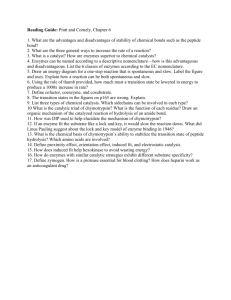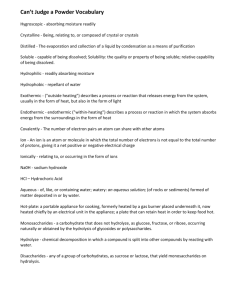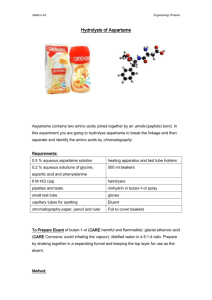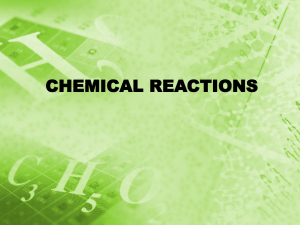Hydrolysis of aspartame and identification of its products by thin
advertisement
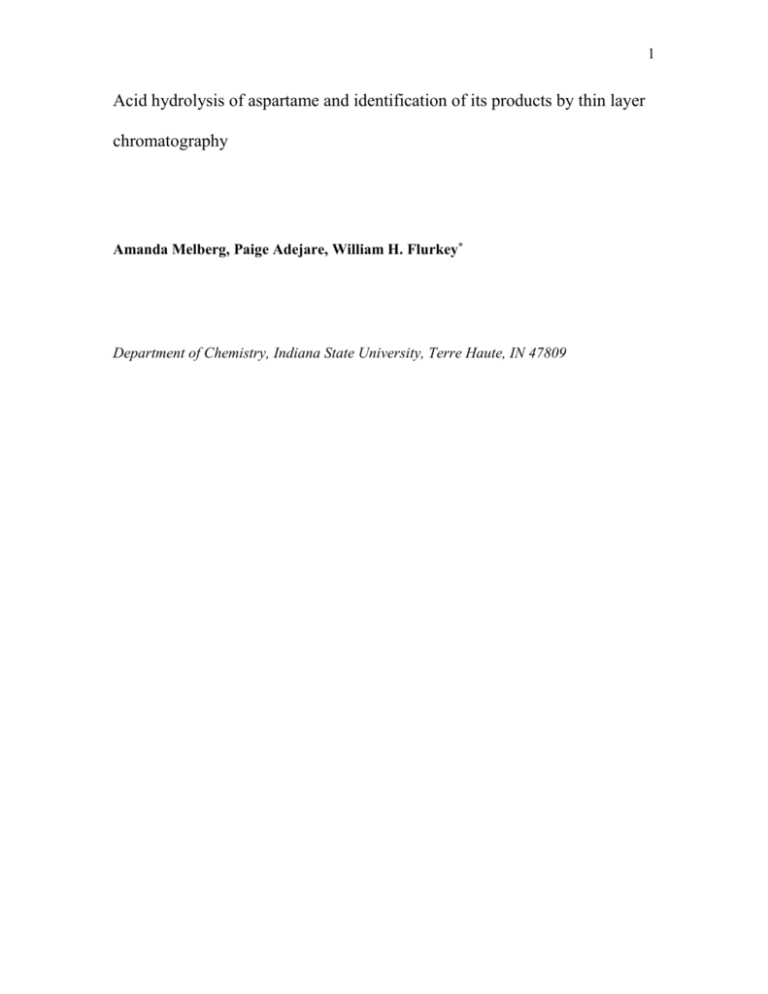
1 Acid hydrolysis of aspartame and identification of its products by thin layer chromatography Amanda Melberg, Paige Adejare, William H. Flurkey* Department of Chemistry, Indiana State University, Terre Haute, IN 47809 2 Abstract: Aspartame, a sugar substitute, is a modified peptide composed of aspartic acid and phenylalanine methyl ester. Hydrolysis of aspartame can produce a variety of products, including α-L-aspartyl-L-phenylalanine, L-phenylalanyl-α-L-aspartic acid, Laspartic acid, L-phenylalanine, and L-phenylalanine methyl ester. Many of these products can be identified using thin layer chromatography. The products from acid hydrolysis of aspartame were followed over a six-hour period using thin layer chromatography. Conversion of aspartame into the peptide aspartyl phenylalanine was observed, followed by conversion of the peptide into aspartic acid and phenylalanine. No conversion of aspartame into phenylalanine methyl ester or a β isomer of aspartyl phenylalanine was observed. This experiment uses common techniques to demonstrate hydrolysis of a peptide and to identify the products obtained from acid hydrolysis of a peptide. 3 Key words: aspartame, Nutrasweet, acid hydrolysis, thin layer chromatography 4 Abbreviations: α APM - Nutrasweet, aspartame, α-L-aspartyl-L-phenylalanine methyl ester β APM - β-L-aspartyl-L-phenylalanine methyl ester DKP - diketopiperazine, 3-methylenecarboxyl-6-benzyl-2,5-diketopiperazine DF - α-L-aspartyl-L-phenylalanine FD - L-phenylalanyl-α-L-aspartic acid βDF - β-L-aspartyl-L-phenylalanine Fme - L-phenylalanine methyl ester D - L-aspartic acid F - L-phenylalanine 5 Introduction Aspartame, commonly known as Nutrasweet, is a low-calorie sweetner used as a sugar substitute. Its serendipitous discovery by a chemist at the G.D. Searle and Company in 1965 and introduction to consumers in 1981, led to a large increase in products containing sugar substitutes (1). In some ways this led to the development of new sugar substitutes such as sucralose, acesulfame K, alitame, neotame, and stevioside to name a few. Not long after the introduction of aspartame, reviews on the properties/stability and safety issues of aspartame appeared in the literature (2-3). Aspartame is a modified peptide (α-L-aspartyl-L-phenylalanine methyl ester, αAPM) containing two common amino acids, aspartic acid and phenylalanine. The peptide can be completely hydrolyzed under highly acidic or basic conditions, generating free amino acids and methanol. Several studies have examined the hydrolysis of aspartame under neutral pH conditions (4), in aqueous solutions (5-6), and in acidic conditions (7-9). Historically, determination of aspartame in food products has been carried using HPLC and thin layer chromatography (TLC) (10-12). Aspartame has been the subject of several chemistry/biochemistry lab experiments. For example, aspartame has been used in a sweetness test for a biochemistry lab (13). Analysis of aspartame in soft drinks has been carried out using UV spectroscopy, HPLC, capillary electrophoresis and mass spectrometry (14-16). The kinetics of aspartame hydrolysis and degradation has also been followed using HPLC (8). This latter experiment is very informative, but may not be practical for many undergraduate labs in terms of time and equipment. Lastly, analysis of aspartame and/or its hydrolysis products by TLC have been used as a lab exercise to demonstrate the composition of aspartame 6 (17-18). In one of these aspartame lab experiments, aspartic acid, phenylalanine, leucine, and aspartame were subjected to TLC to illustrate the composition and polarity of aspartame and its products, but hydrolysis of aspartame was not performed (17). In another aspartame lab experiment, hydrolysis of aspartame was carried out under basic conditions, but no actual TLC chromatograms were given to identify the products or to show migration patterns (18). Conceptually, our primary goal was to carry out acid hydrolysis of aspartame in order to demonstrate the composition of a small peptide. A secondary goal was to monitor the progress of the hydrolysis reaction within a three-hour time frame using a relatively inexpensive visual method of analysis. A third goal to demonstrate that separation of the products (amino acids) by TLC is based on their polarity. Specifically, the products from acid hydrolysis of aspartame were monitored using TLC over an extended time period to show formation of the peptide aspartyl phenylalanine (DF) followed by hydrolysis of this peptide into aspartic acid (D) and phenylalanine (F). This experiment clearly demonstrates conversion of a reactant into a product(s). This experiment was developed by students participating in undergraduate research. It has been carried out by dietetic students in a sophomore/junior level one semester survey of biochemistry course and lab. Because these students have only had one year of general, organic, and biochemistry less emphasis was spent of the chemistry of the reaction and more time was spent on demonstrating the composition of Nutrasweet. This experiment can be easily adapted for a senior level biochemistry lab in a variety of formats and will be tested out using a variety of hydrolysis conditions. We anticipate this 7 experiment could also be used in a general education chemistry course to demonstrate the biological composition of a familiar consumer product. We believe this experiment could be a valuable, interesting, and practical addition to a biochemistry lab course because the reactants and products can be easily visualized, it is simple and can be completed within two 3 hour lab periods, and it could potentially be used in a wide variety of undergraduate chemistry or biochemistry lab courses ranging from introductory to advanced levels. Experimental Chemicals. Aspartame, β-aspartame, α-aspartyl-phenylalanine, β-aspartylphenylalanine, phenylanyl-aspartic acid, aspartic acid, phenylalanine, and phenylalanine methyl ester were obtained from Sigma Chemical Company (St. Louis, MO) or Bachem Americas, Inc. (Torrance, CA). Silica gel thin layer chromatography plates (silica gel G 60 F, 250 μM, 10 x 20 cm) on a glass backing were from EMD chemicals. All other chemicals were of reagent grade. Procedure. Aspartame (4 mg/ 0.4 mL) was dissolved in 2 M HCl in a 1 mL glass vial (Kontes) and placed in an aluminum heat block set at 95-100 o C. Alternatively, the sample can be placed in a plastic microfuge tube used for thermocyclers. Aliquots of 10 μL were removed at various time intervals (0, 0.5, 1, 2, 4, 6, 18 hours), placed into microfuge tubes and immediately transferred to a freezer. Care should be used in removing samples from the heat block since the glass vials are very hot. These aliquots can be removed by the instructor or by students after the 3 hour lab is over, especially if the lab begins in the morning. Samples were thawed at room temperature and then 8 mixed well. 0.5 μL from each hydrolysis sample was spotted on a silica gel TLC plate using a 1 μL syringe. The syringe was rinsed four times with water before spotting another sample. One μL capillary tubes from Drummond can also be used to spot samples. Standards were prepared fresh on the day of the lab at a concentration of 1 mg per 0.1 mL of 2 M HCl. Standards included α-aspartame, aspartic acid, phenylalanine, αaspartyl-phenylalanine, phenylalanyl-aspartic acid, phenylalanine methyl ester, βaspartyl phenylalanine, and, in some cases, β-aspartame. One packet of Equal, containing approximately 38 mg of aspartame, was dissolved in 5 mL of 2 M HCl and also used as a standard in some experiments. The samples and standards spotted on the TLC plate (10 x 10 cm or 10 x 20 cm) were allowed to dry, and the plates were then placed in a mini - TLC tank containing butanol: acetic acid: water (6:1:1) as a solvent (17). The solvent was allowed to move up the plate until it reached near the top of the plate, requiring approximately 1.5-2 hours. The plates were removed and dried with a hair dryer. The plates were then dipped in a 0.5 % ninhydrin/ethanol solution and dried again with a hair dryer. The plates were then placed in an oven at 110 oC for about 5 min for color development. The color and position of any spots were noted. Patterns of the stained samples were clearly visible on the day of staining. However, the color intensity of the individual spots varied with the time of heating and gradually faded away with time. Some TLC plates were scanned using a UMAX Astra 4950 scanner and stored as digital images. We have increased the intensity of the spots in the original chromatograms using the photo-imaging software in order to make stained samples in the figures more visible. Alternatively, the TLC plates can be viewed under UV light at 9 either 254 nm or 365 nm and images captured with suitable photo-documentation systems. Results and Discussion A variety of products can be formed during hydrolysis of aspartame depending on the conditions (flow diagram in Fig. 1). The structural representations of these products are shown in Figure 2. Samples taken at various time intervals during hydrolysis may yield the peptide aspartyl-phenylalanine (DF), phenylalanine methyl ester (Fme), aspartic acid (D), and or phenylalanine (F). Complete hydrolysis of aspartame should yield aspartic acid, phenylalanine, and methanol as products. The standards used in this experiment were subjected to TLC and stained with ninhydrin to localize any compounds with free amino groups (Fig. 3). We tested a variety of TLC solvents, TLC media, hydrolysis conditions, and staining methods using these standards to identify conditions suitable for the lab experiment (data not shown). Each of the standards showed a slightly different mobility except for phenylalanine (F) and aspartame (APM). These two compounds have similar mobility but do have slightly different stain colorations. The standards in Fig. 3 indicate that one can differentiate between DF, FD, D, F, and Fme using TLC. Therefore, one should be able to follow the products formed during hydrolysis using TLC. β APM and β DF have different migration patterns and staining patterns compared to their corresponding α isomers (Fig. 3). Thus, one should also be able to detect any potential isomerization of these two compounds during hydrolysis. If APM (either α or β isomer) is dissolved in 2 M HCl shortly before the experiment, it does not show partial conversion into DF, D and F. 10 However, we have noticed partial hydrolysis of APM if the samples are stored in 2 M HCL for several hours at room temperature before the experiment or TLC is started. An example of acid hydrolysis of APM and the products formed during hydrolysis is shown in Fig. 4. Rm values were determined for the standards and the products detected at the 1.5 hr time point. Although one can use Rm values to identify the products, it is much easier to observe the spot patterns and coloration for identification of compounds since some of the products and starting material have similar Rm values. At zero time, APM is the primary component observed. At 30 min, the peptide DF is clearly visible as well as the amino acids, D and F, compared to the migration pattern and Rm values of the standards. This pattern would be expected if partial hydrolysis had occurred. At 30 min, there does not seem to be any Fme present, suggesting that hydrolysis of the ester group has taken place before hydrolysis of the peptide bond. As the time of hydrolysis increases, smaller amounts of the peptide DF are present and increasing amounts of D and F are apparent. In other words, the intensity of the spot corresponding to DF decreases and the intensities of the spots corresponding to the products D and F increase. Because αAPM and F have similar mobilities and Rm values under these TLC conditions we can only assume the amount of APM is decreasing with time. Complete hydrolysis of APM usually required longer than two hours under our experimental conditions. In addition, as hydrolysis occurred there did not seem to be a rearrangement or conversion of DF into FD or into β APM or β DF (compare Fig. 1 and Fig. 4). These compounds have different colorations and Rm values. Although some of the hydrolysis products may be derived from DKP, this compound is not detected by ninhydrin staining at the μg level 11 (12). Therefore, we do not observe DKP as an intermediate product during the hydrolysis. Under basic conditions APM forms DKP and/or DF and methanol (4, 7, 9). In preliminary trials for this experiment we also tried to carry out hydrolysis of APM using 2 M KOH and observed that complete hydrolysis took much longer than when using acidic conditions. We did, however, observe the formation of D and F, but APM and DF showed similar mobilities during TLC, making it difficult to monitor the disappearance of APM and DF with time (data not shown). Not only did hydrolysis take longer, but the spots were somewhat distorted on the TLC plates. Therefore, we did not pursue base hydrolysis of Nutrasweet further for use as an experiment in the biochemistry lab. However, during the time it takes for chromatography to finish, it might be advantageous to discuss possible mechanisms of acid and base catalysis of Nutrasweet. Under mildly acidic and neutral pH conditions, an intramolecular cyclization of APM with loss of methanol occurs to form DKP as the primary product (4-6, 9, 19). Hydrolysis of the methyl ester without cyclization yields the peptide DF as well as the free amino acids D and F due some hydrolysis of the peptide bond. Mildly acidic and neutral pH conditions can also lead to the formation of the β isomers of APM and DF (4, 6, 7). In preliminary trials we have also tried hydrolysis using mildly acidic conditions (citrate buffer pH 4.5) and neutral conditions (phosphate buffer pH 7.0), but observed little hydrolysis of APM and little conversion to D and F (data not shown). In addition, we did not observe any isomerization of APM to β APM which has been reported under similar conditions (4,6,7). 12 In more acidic hydrolysis conditions (pH < 2) DF should form from loss of methanol (7, 9). In addition, less DKP should be formed by intramolecular cyclization. The peptide bond of DF is then hydrolyzed to yield D and F. This is very similar to what we observed in our experiments using our acidic hydrolysis conditions and analysis by TLC. In summary, under acidic conditions, we observed formation of DF, D and F within 30 min of hydrolysis (Fig. 4). We did not observe formation of any β isomers of APM or DF, nor did we observe isomerization of DF into FD. This is also consistent with the hydrolysis products expected under more acidic conditions. Our lab procedure for acid hydrolysis of aspartame is more instructive than simply performing TLC using D, F, and APM to illustrate conversion of aspartame into its component amino acids (17). We believe it may also be more useful than hydrolysis using KOH (18) since we have noticed that this hydrolysis reaction takes longer and the products do not separate as well by TLC (data not shown). In addition, the results from this experiment are not as instrumentation intensive as those reported by Williams et. al. for examining the kinetics of APM hydrolysis (8). Our protocol is well suited for monitoring several products from hydrolysis of aspartame and can be carried out in the three-hour time blocks commonly used in many educational laboratories. This experiment also fulfills our intent to demonstrate peptide composition and hydrolysis of a peptide using a familiar commercial sweetner/modified peptide. It also simulates the process that is probably occurring during digestion using peptidases and indicates how amino acids are derived from APM. Depending on the nature of the course in which it is used, this laboratory exercise could be modified or extended in a variety of ways to illustrate various concepts in 13 chemistry and biochemistry. It could be modified to compare acid and base hydrolysis of APM, to quantify the reactants and products of hydrolysis by densitometry, or to look for the formation of different products (such as the β isomers) using neutral and mildly acidic conditions. This same procedure could be carried out using β APM and either acid or base hydrolysis to determine if the reactions result in conversion to any α isomers. One could also use a peptidase(s) to carry out this reaction and compare the products to acid hydrolysis. Lastly, this experiment could be coupled with model building, either using a computer or with ball and stick/space filling molecular models. While the students are waiting during the hydrolysis and/or TLC part of the experiment, this model building exercise could be used to illustrate which bonds are broken and what products are formed. Conclusions We have described a biochemistry lab experiment that demonstrates acid hydrolysis of aspartame, a small peptide used as a sugar substitute. The conversion of the peptide into amino acids was followed over an extended time period using thin layer chromatography. This experiment does not use specialized equipment and can be completed within time constraints common to many laboratory settings. The experiment can be used in beginning and advanced chemistry/biochemistry classes in a variety of formats and provides an introduction to separation and characterization of amino acids and peptides. 14 Acknowledgments We would like to thank Dr. Jennifer Inlow for a critical evaluation of this manuscript and Dr. Richard Kjonaas for providing the figures using Chem Draw. 15 References 1. Wikipedia, the free encyclopedia, www.wikipedia.org 2. Homler, B. E. Food Tech. 1984, 38, 50-55. 3. Stegink, L. B. Food Tech. 1987, 41, 119-121. 4. Tsoubeli, M. N.; Labouza, T. P. J. Food Sci. 1991, 56, 167-175. 5. Prudel, M.; Davidkova, E.; Davidek, J.; Kminek, M. J. Food Sci. 1996, 51, 1393-1397. 6. Bell, L. N.; Wetzel, C. R. J. Agric. Food Chem. 1995, 43, 2608-2612. 7. Prankerd, R. J.; Stone, H. W.; Sloan, K. B.; Perrin, J. M. Int. J. Pharmaceut. 1992, 88, 189-191. 8. Williams, K. R.; Adhyaru, B.; Timofeev, J.; Blankenship, M. K. J. Chem. Ed. 2005, 82, 924-925. 9. Skwierczynski, R. D.; Connors, K.A. Pharm. Res. 1993, 10, 1174-1179. 10. Daniels, D. H.; Joe, F. L.; Warner, C. R.; Fazio, T. J. Assoc. Off. Anal. Chem. 1983, 67, 513-517. 11. Fox, L.; Anthony, G. D.; Lau, E. P. K. J. Assoc. Off. Anal. Chem. 1976, 59, 1048-1050. 12. Sherma, J.; Chapin, S.; Follweiler, J. M. Amer. Lab. 1985, 17, 131-133. 13. Stein, P. J. J. Chem. Ed. 1997, 74, 1112-1113. 14. Delaney, M. F.; Pasko, K. M.; Mauro, D. M.; Gsell, D. S.; Korologos, P. C.; Morawski, J.; Krolokowski, L. J.; Warren, F. V. J. Chem. Ed. 1985, 62, 615-620. 15. McDevitt, U. L.; Rodriguez, A.; Williams, K. R. J. Chem. Ed. 1998, 75, 625-629. 16. Bergen, H. R.; Benson, L. M.; Naylor, S. J. Chem. Ed. 2000, 77, 1325-1326. 17. Conklin, A. R. J. Chem. Ed. 1987, 64, 1065-1066. 16 18. Peller, J. R. Aspartame: the study of a peptide bond in Exploring Chemistry: laboratory experiments in general, organic, and biological chemistry. Pearson, Princeton, NJ. 2004, 321-331. 19. Furda, I.; Malizia, P. D.; Kolor, M. G.; Vernieri, P. T. J. Agric. Food Chem. 1975, 23, 340-343. 17 Table legends Table 1. Rm values of Nutrasweet and its products Rm values (distance unknown traveled/distance solvent traveled) were determined using standards and samples in Fig. 4. The 1.5 hr time point was used to determine Rm values of the three spots detected – brown, red, and blue. Abbreviations are defined in the text. Figure legends Fig. 1. Diagram of potential products from hydrolysis of α aspartame. Abbreviations are defined in the text. Fig. 2. Structural drawings of α aspartame and its potential products after hydrolysis. Abbreviations are defined in the text. Fig. 3. Thin layer chromatography of amino acid and peptide standards TLC was carried out as described in the experimental section. (D) L-aspartic acid; (F) L-phenylalanine; (α DF) α-L-aspartyl-L-phenylalanine; (α FD) L-phenylalanyl-α-Laspartic acid; (Fme) L-phenylalanine methyl ester; (α APM) α aspartame; (β APM) β aspartame; (β DF) β L-aspartyl-L-phenylalanine. Samples were subjected to TLC for one hour and then stained with ninhydrin. 18 Fig. 4. Hydrolysis of aspartame and thin layer chromatography of the products Hydrolysis of aspartame and TLC were carried out as described in the experimental section. Samples were withdrawn at 0 min, 30 min, 60 min , 90 min, 2 hours, 4 hours, and 6 hours and then subjected to TLC for one hour followed by staining with ninhydrin. Standards: L-aspartic acid (D), L-phenylalanine (F), α-L-aspartyl-L-phenylalanine (άDF), aspartame (α-APM), L-phenylalanyl-α-L-aspartic acid (ά-FD), L-phenylalanine methyl ester (Fme), and β aspartame (β-APM) were also subjected to TLC on the same plate at the same time. 19 Table 1 Rm values of NutraSweet and its products Sample Rm D 0.11 F 0.36 DF 0.25 αAPM 0.36 FD 0.31 FMe 0.48 βAPM 0.3 1.5 hr spots brown 0.36 red 0.25 blue 0.111 20 Figure 1 α APM → Fme, D → ά FD ↑↓ α DF ← DKP ↓ ↓↑ D, F β APM ↓ D, F 21 Figure 2 22 Figure 3 23 Figure 4 24
